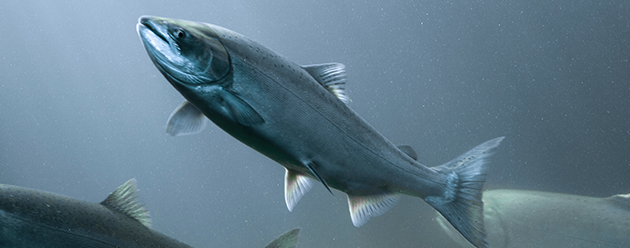
A Closer Look At The Fish We Help Care For
September 15, 2016
Fish are unique among the species at Zoetis because different types of fish are treated by different types of medicine. In this article, we take a closer look at the fish we help care for.
As part of our series about the animals we care for, we are taking a closer look at fish.
Fish are unique among the species at Zoetis because different types of fish are treated by different types of medicine. Therapies for salmon are different than therapies for tilapia. Very rarely are bacterial threats the same in different types of fish—and they even vary by region.
Deep history in aquaculture
At Zoetis, our fish therapies come from PHARMAQ, the global leader in vaccines and innovation in aquaculture. In 2015, Zoetis acquired PHARMAQ, a Norway-based company with deep history in aquaculture health. In the early 1990’s, PHARMAQ first introduced injectable, oil-based vaccines to the market. Before that, fish farmers in Norway had to rely on antibiotics to keep their fish healthy. These new vaccines revolutionized the farming of Norwegian salmon. Since their introduction, the industry has reduced its use of antibiotics by 99.8% per ton of trout and salmon produced. And Norwegian salmon farming has grown tremendously—from 57,000 tons in 1987 to 1.25 million tons in 2015.
During the last year, PHARMAQ has sold more than 600 million doses of 25 different types of vaccines.
Solving health problems for fish
Our R&D team has a long history of solving health problems for fish. For example, we had developed therapies for most diseases afflicting salmon in Norway, but salmon in Chile were facing a severe disease called Salmon Rickettsial Septicaemia (SRS) syndrome. The PHARMAQ R&D team tackled this problem and in 2015 launched the first live vaccine to help combat SRS called ALPHA JECT LiVac® SRS. This groundbreaking vaccine was welcomed by the Chilean fish farming industry who had suffered economic losses and needed more predictable and reliable fish production.
Some of our top fish therapies
Fish therapies mostly fall into two categories: vaccines and parasiticides. Vaccines help protect fish against bacterial and viral diseases. Parasiticides kill parasites on fish. We offer a range of products in these categories. We also offer diagnostic tools to help diagnose health conditions in fish.
Some of our top therapies and diagnostics include:
Vaccines
-
-
Help prevent Furunculosis, Vibriosis, Coldwater vibriosis, Winter sore and Infectious Pancreatic Necrosis (IPN).
-
Available in Norway
-
-
-
Helps prevent Vibriosis and Pasteurellosis
-
Available in the Mediterranean
-
-
-
Helps prevent Furunculosis, Vibriosis, IPN, Infectious Salmon Anemia (ISA), Salmon Rickettsial Septicemia (SRS)
-
Available in Chile
-
-
-
Helps prevent SRS
-
Available in Chile
-
Parasiticide
-
ALPHA MAX®, AMX®, and AMX® Deltametrina
-
Treats sea lice
-
Available in Norway, UK, Ireland, and Chile
-
Diagnostics
-
Real Time RT-PCR
-
A diagnostic that can identify 58 different fish pathogens
-
-
Histology
-
This identifies tissue changes in fish. We offer it in combination with Real Time RT-PCR in order to confirm a diagnosis in fish
-
-
ATPase
-
A test that monitors salmonids’ reaction to fresh water and saltwater. It provides farmers with data to determine the right time to move their salmon from fresh water into the sea.
-
For all of our diagnostic methods, we provide fish farmers with technical consulting based on the results we find.
Our customers, big and small
While our story began with salmon in Norway, we continue to expand our aquaculture expertise into many other regions of the world and many other fish species. Our customers range from the leading salmon industry in Norway to backyard family farmers in Vietnam.
Some of our biggest customers remain the salmon industry in Norway, the United Kingdom, and Chile. In the last eight years, we have gained new customers in the farmers of sea bass and sea bream in the Mediterranean Sea, tilapia in Central America, and pangasius fish in Vietnam.
We work closely with fish farmers, scientific institutes, fish health personnel, and regulators to provide environmentally sound, safe, and efficacious products for the aquaculture industry.
We make aquaculture progress
The future of aquaculture is one of growth. The world’s production of farmed fish is expected to grow from 40 million tons in 2011 to an estimated 71 million in 2021.
The demand for fish is growing because the world’s population is growing. Fish is a sustainable, high-value protein that is efficient to farm and affordable to eat. It is also environmentally friendly. For example, salmonids need only one kilogram of feed to grow one kilogram of fish, which is a highly efficient ratio especially compared to other feed animals. Fish farming produces less carbon dioxide than other livestock farming. And it has a fast production cycle. Salmon can grow from hatch to salmon in three years; tilapia grows in less than one year.
We care about the fish from egg to table. As the demand for fish grows, we will continue to provide innovative solutions to help improve the health of fish.
Learn more
Watch this video about our work in aquaculture health
Visit the PHARMAQ website